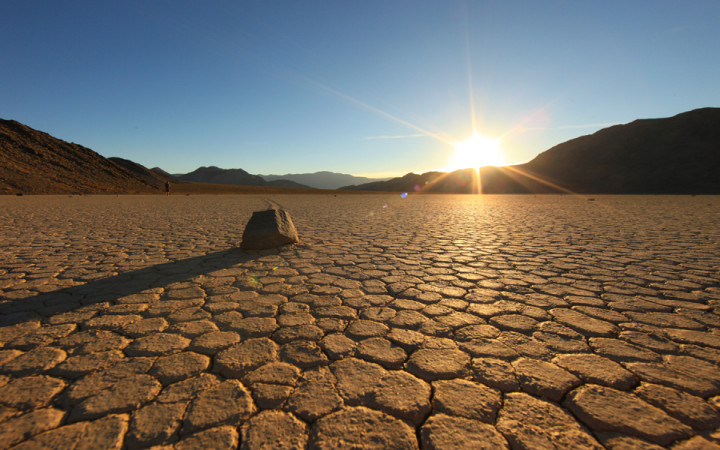Today’s Wonder of the Day was inspired by Makayla. Makayla Wonders, “How do sailing stones move?” Thanks for WONDERing with us, Makayla!
Picture it: You’re trekking through Death Valley, the hottest place on Earth. You come across tracks in the sand. But these are no normal tracks. Instead of footprints or paw prints, you’re following one thin, long line. What could make a track like this? A snake? A person on a unicycle? You keep moving, and finally, you get to the end of the line. There it is, the object that made this track. It’s . . . a rock?
You’ve found a sailing stone! They’ve only ever been seen in Racetrack Playa, which was once a lake. That changed as a result of dramatic climate change that occurred over 10,000 years ago. This resulted in the evaporation of the entire lake. It left behind light brown mud that’s more than 1,000 feet thick.
Today, Racetrack Playa receives only about one to two inches of rain each year. This dry and incredibly hot environment is one of the harshest on Earth. Footprints left on the playa can last for many years before enough moisture and wind erase them.
Erosion of the surrounding mountains causes rocks of all different sizes to fall to the surface of Racetrack Playa. For many years, visitors to Racetrack Playa have noticed that these rocks appear to have moved by themselves. Clear tracks behind the rocks revealed that some of them had moved as much as 1,500 feet. Since there were no footprints around, these rocks—the sailing stones—were somehow moving on their own.
But how is that possible? Rocks don’t have feet. Have you ever seen a rock move on its own? Of course not! The sailing stones of Racetrack Playa baffled scientists. Sure, there were plenty of theories. From aliens to some sort of weird magnetic effect, none of these theories could ever be proven with physical evidence.
Scientists who studied the rocks noticed that not all of them moved. The ones that did move only did so every two or three years. Further complicating things was the fact that the stones never moved at the same time or in the same direction. What’s going on at Racetrack Playa?
Recently, scientists used time-lapse photography, motion-activated GPS receivers, and a great deal of patience to solve the mystery. They found that the stones’ movement is caused by a unique combination of water, ice, and wind.
When the playa fills with water after it rains or snow melts from nearby mountains, thin sheets of floating ice can form during cold winter nights. As temperatures rise during the day, the sheets of ice start to melt and break into large, jagged panels of ice that resemble broken windows.
These panes of ice can be pushed easily across the slick, wet mud by even light breezes. As they move across the playa, they push rocks in front of them. The rocks leave trails in the mud below as they move. When the ice is gone and the playa dries out, all you can see is the rock and the evidence of how far it has moved.
The mystery may be solved, but the sailing stones are still fascinating for many people. Would you like to visit Racetrack Playa to look for sailing stones one day? Maybe you’ll catch one in motion!
Standards: CCRA.L.3, CCRA.L.6, CCRA.R.1, CCRA.R.2, CCRA.R.4, CCRA.R.10, CCRA.SL.1, CCRA.SL.2, CCRA.W.2, CCRA.W.9, CCRA.L.1, CCRA.L.2





